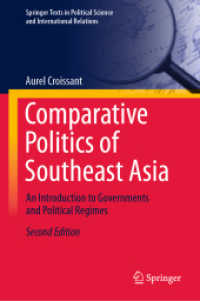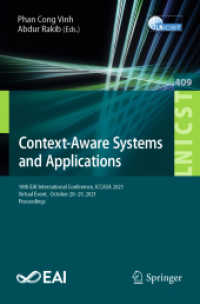- ホーム
- > 洋書
- > 英文書
- > Business / Economics
Full Description
Master the tools and techniques needed to design, conduct, and analyze research projects effectively
Research Methods for Business, 9th Edition explains the principles and practices of using a systematic, organized research approach, facilitating the development of effective solutions to business challenges. Designed to help students view research from the perspective of management, this leading textbook guides readers through the entire business research process while fostering a deeper understanding of how to conduct rigorous, relevant, and ethical research.
WILEY ADVANTAGE
Provides a clear, student-friendly introduction to business research with an informal and accessible writing style
Covers a wide range of business research methods and practices used in areas such as human resources management, strategic management, operations management, finance, and accounting
Integrates real-world case studies and examples from various business disciplines to illustrate key concepts
Emphasizes both scientific and pragmatic approaches to research to ensure a well-rounded understanding
Enhances critical thinking and problem-solving skills through structured exercises and hands-on activities
AN INTERACTIVE, MULTIMEDIA LEARNING EXPERIENCE
This textbook includes access to an interactive, multimedia e-text. Icons throughout the print book signal corresponding digital content in the e-text.
Videos: Research Methods for Business integrates abundant video content developed by the authors to complement the text and engage readers more deeply.
Interactive Self-Scoring Quizzes: Concept Check Questions at the end of each section provide immediate feedback, helping readers monitor their understanding and mastery of the material.
Downloadable Files: Additional Cases and SPSS Data Sets can be found throughout the text, helping students further engage with the content.
Contents
Preface xxi
About the Authors xxiv
1 Introduction to Research 1
Introduction 1
Business Research 2
Research and the Manager 3
Types of Business Research: Applied and Basic 4
Applied Research 5
Basic or Fundamental Research 7
Managers and Research 7
Why Managers Need to Know About Research 7
The Manager and the Consultant-Researcher 8
Internal Versus External Consultants/Researchers 9
Internal Consultants/Researchers 9
Advantages of Internal Consultants/Researchers 9
Disadvantages of Internal Consultants/Researchers 9
External Consultants/Researchers 10
Advantages of External Consultants/Researchers 10
Disadvantages of External Consultants/Researchers 10
Knowledge About Research and Managerial Effectiveness 11
Ethics and Business Research 11
Summary 12
Discussion Questions 13
Case: The Laroche Candy Company 14
Case Questions 16
2 The Scientific Approach and Alternative Approaches to Investigation 17
Introduction 17
The Hall marks of Scientific Research 18
Purposiveness 18
Rigor 18
Testability 19
Replicability 19
Precision and Confidence 19
Objectivity 20
Generalizability 20
Parsimony 20
The Hypothetico- Deductive Method 21
The Seven- Step Process in the Hypothetico- Deductive Method 21
Identify a Broad Problem Area 21
Define The Research Problem 22
Develop Hypotheses 22
Determine Measures 22
Data Collection 22
Data Analysis 22
Interpretation of Data 23
Review of the Hypothetico- Deductive Method 23
Alternative Approaches to Research 24
Positivism 24
Constructionism 24
Critical Realism 25
Pragmatism 25
A Pragmatic Approach to Research 26
Organizational Challenges and Opportunities 26
Organizational Change: A Specific Case and Approach 27
The Initial Stages: The Manager Starts Exploring 29
The Initial Stages: Briefing the Researcher 30
Defining the Organizational Problem 31
Defining the Research Problem 32
Developing a Research Proposal 32
A Critical Literature Review 32
The Planning Collection and Analyses of Data 32
Conclusions and Recommenda tions 33
The Final Stages: The Manager Makes a Decision and Acts 33
Comparing Two Important Approaches 33
Conclusion 34
Summary 34
Discussion Questions 35
3 Defining the Management Problem 37
Introduction 37
Organizational Challenges and Opportunities 37
The First Step of the Research Process: Exploration 38
To Conduct Research or Not 38
Defining the Management Problem 39
Applied Research in Support of a Process of Planned Change 40
The First Step of the Research Process in Change Situations: Exploration 40
The Second Step of the Research Process: Diagnosis 42
The Constraints or Preconditions That Should be Taken into Account 46
Different Types of Problems and Solutions to These Problems 46
Providing Feedback to the Client Organization 49
Managerial Implications 49
Summary 50
Discussion Questions 51
Appendix: Background Information on the Organization 52
4 Defining the Research Problem 54
Introduction 54
Defining the Research Problem 54
What Makes a Good Problem Statement? 54
Basic Types of Questions: Exploratory Descriptive and Causal Questions 58
Exploratory Research Questions 58
Descriptive Research Questions 59
Causal Research Questions 60
The Research Proposal 61
Managerial Implications 64
Ethical Issues in the Preliminary Stages of Investigation 64
Summary 65
Discussion Questions 65
5 The Critical Literature Review 67
Introduction 67
Definition and Functions of the Critical Literature Review 67
How to Approach the Literature Review 69
Data Sources 69
Textbooks 69
Journals 69
Theses 69
Conference Proceedings 69
Unpublished Manuscripts 69
The Internet 70
AI Tools 70
Searching for Literature 70
Evaluating the Literature 71
Reading Strategies 72
Documenting the Literature Review 72
Citing Sources in Your Literature Review 76
Reference and Citation Management Programs 78
On the Use of AI and Large Language Models 78
Ethical Issues 79
Final Note 80
Summary 80
Discussion Questions 81
Practice Project 82
Appendix: Some Online Resources Useful for Business Research 83
Online Databases 83
On the Web 84
Accounting and Finance 84
Economics and Econometrics 84
Environmental Science 85
Marketing 85
Organizational Behavior and Human Resources 86
Strategic Management and Management Science 86
Tourism Leisure and Hospitality Management 86
Overview of Academic Top Journals Per Subject Area 87
Accounting and Finance 87
Economics and Econometrics 87
Environmental Science 87
Management Science and Operations Research 88
Marketing 88
Organizational Behavior and Human Resources 89
Strategic Management 89
Tourism Leisure and Hospitality Management 89
Apa Guidelines 90
APA Format for Referencing Relevant Articles 90
Specimen Format For Citing Different Types of References (Apa Format) 90
Referencing and Quotation in the Literature Review Section 91
Quotations in Text 92
Sample Apa Style Student Papers 94
6 Theoretical Framework and Hypothesis Development 95
Introduction 95
The Need for a Theoretical Framework 96
Variables 97
Dependent Variable 97
Independent Variable 98
Moderating Variable 100
The Distinction Between an Independent Variable and a Moderating Variable 101
Mediating Variable 103
How Theory Is Generated 104
The Components of the Theoretical Framework 105
Hypothesis Development 106
Definition of a Hypothesis 106
Statement of Hypotheses: Formats 107
If-then Statements 107
Directional and Nondirectional Hypotheses 107
Null and Alternate Hypotheses 108
Managerial Implications 112
Summary 113
Discussion Questions 113
Practice Project 115
7 Elements of Research Design 116
Introduction 116
The Research Design 116
Elements of Research Design 117
Research Strategies 117
Experiments 118
Survey Research 118
Ethnography 118
Case Studies 119
Grounded Theory 119
Action Research 120
Qualitative Versus Quantitative Research 120
Extent of Researcher Interference With the Study 122
Study Setting: Contrived and Noncontrived 123
Unit of Analysis: Individuals Dyads Groups Organizations Cultures 125
Time Horizon: Cross- Sectional Versus Longitudinal Studies 127
Cross- Sectional Studies 127
Longitudinal Studies 127
Trade- Offs and Compro mises 128
Managerial Implications 129
Summary 129
Discussion Questions 130
8 Interviews 131
Introduction 131
Primary Data Collection Methods 131
Interviews 132
Unstructured and Semi-Structured Interviews 133
Unstructured Interviews 133
Semi- Structured Interviews 133
Training Interviewers 134
Some Tips to Follow When Interviewing 135
Establishing Credibility and Rapport and Motivating Individuals to Respond 135
The Questioning Technique 136
Review of Tips to Follow When Interviewing 137
Face- To- Face Online and Telephone Interviews 137
Face-to- Face Interviews: Advantages and Disadvantages 138
Online Interviews: Advantages and Disadvantages 138
Telephone Interviews: Advantages and Disadvantages 138
Personal and Group Interviews 139
Focus Groups 139
Expert Panels 140
Advantages and Disad vantages of Interviews 141
Summary 142
Discussion Questions 142
9 Observation 144
Introduction 144
Definition and Purpose of Observation 145
Four Key Dimensions That Characterize the Type of Observation 145
Controlled Versus Uncontrolled Observational Studies 145
Participant Versus Non- Participant Observation 146
Structured Versus Unstructured Observational Studies 146
Concealed Versus Unconcealed Observation 147
Online Observation 147
Two Important Approaches to Observation 148
Participant Observation: Introduction 148
The Participatory Aspect of Participant Observation 149
The Observation Aspect of Participant Observation 150
What to Observe 151
Structured Observation: Introduction 153
The Use of Coding Schemes in Structured Observation 153
Advantages and Disadvantages of Observation 155
Summary 157
Discussion Questions 157
10 Administering Questionnaires 159
Introduction 159
Types of Questionnaires 159
Personally Administered Questionnaires 160
Self- Administered Questionnaires 160
Mail Questionnaires 160
Electronic and Online Questionnaires 160
Guidelines For Questionnaire Design 162
Principles of Measurement 162
Principles of Wording 163
Content and Purpose of the Questions 164
Language and Wording of the Questionnaire 164
Type and Form of Questions 164
General Appearance or 'Getup' of the Questionnaire 166
A Good Introduction 166
Organizing Questions Giving Instructions and Guidance and Good Alignment 167
Personal Data 168
Information on Income and Other Sensitive Personal Data 168
Open- Ended Question at the End 169
Concluding the Questionnaire 169
Sequencing of Questions 169
Administrative and Classification Questions 170
Review of Questionnaire Design 171
Pretesting of Structured Questions 171
Electronic Questionnaire and Survey Design 171
International Dimensions of Surveys 172
Special Issues in Instrumentation for Cross- Cultural Research 172
Other Issues in Cross- Cultural Data Collection 173
Review of the Advantages and Disadvan tages of Different Data Collection Methods and When to Use Each 173
Multimethods of Data Collection 174
A Brief Introduction of Codebooks 174
Managerial Implications 174
Ethics in Data Collection 175
Ethics and the Researcher 175
Ethical Behavior of Respondents 176
Summary 176
Discussion Questions 177
11 Experimental Designs 180
Introduction 180
The Lab Experiment 183
Control 183
Manipulation 183
Controlling the Contaminating Confounding or "Nuisance" Variables 185
Matching Groups 185
Randomization 185
Internal Validity of Lab Experiments 186
External Validity or Generalizability of Lab Experiments 186
The Field Experiment 187
External and Internal Validity in Experiments 187
Trade- Off Between Internal and External Validity 187
Factors Affecting the Validity of Experiments 188
History Effects 188
Maturation Effects 189
Testing Effects 189
Selection Bias Effects 190
Mortality Effects 190
Statistical Regression Effects 191
Instrumentation Effects 191
Identifying Threats to Validity 192
Review of Factors Affecting Internal and External Validity 193
Types of Experimental Design and Validity 193
Quasi- Experimental Designs 194
Pre- test and Post- test Experimental Group Design 194
Post- tests Only with Experimental and Control Groups 194
Time Series Design 195
True Experimental Designs 196
Pre- test and Post- test Experimental and Control Group Design 196
Solomon Four- Group Design 197
Double- Blind Studies 198
Ex Post Facto Designs 199
Simulation 199
Ethical Issues in Experimen tal Design Research 199
Managerial Implications 200
Summary 202
Discussion Questions 203
Appendix: Further Experimental Designs 204
The Completely Randomized Design 204
Randomized Block Design 205
Latin Square Design 205
Factorial Design 206
12 Measurement of Variables: Operational Definition 207
Introduction 207
How Variables are Measured 207
Operational Definition (Operationalization) 209
Operationalization: Dimensions and Elements 211
Operationalizing the (Multidimensional) Construct of Achievement Motivation 211
What Operationalization Is Not 213
Review of Operationalization 213
International Dimensions of Operationalization 214
Summary 214
Discussion Questions 214
13 Measurement of Variables: Scaling Reliability and Validity 216
Introduction 216
Four Types of Scales 216
Nominal Scale 217
Ordinal Scale 218
Interval Scale 219
Ratio Scale 219
Ordinal or Interval? 220
Rating Scales 221
Dichotomous Scale 221
Category Scale 221
Semantic Differential Scale 222
Numerical Scale 222
Itemized Rating Scale 222
Likert Scale 223
Fixed or Constant Sum Scale 223
Stapel Scale 224
Graphic Rating Scale 224
Consensus Scale 225
Other Scales 225
Ranking Scales 225
Paired Comparison 225
Forced Choice 226
Comparative Scale 226
International Dimensions of Scaling 226
Goodness of Measures 226
Validity 227
Content Validity 227
Criterion- Related Validity 228
Construct Validity 228
Reliability 230
Stability of Measures 230
Internal Consistency of Measures 230
Reflective Versus Formative Measurement Scales 231
What is a Reflective Scale? 231
What is a Formative Scale and Why Do the Items of a Formative Scale Not Necessarily Hang Together? 231
Summary 232
Discussion Questions 233
Appendix: Examples of Some Measures 234
Measures From Behavioural Finance Research 234
Information Overload 234
Orientation Toward Finance: Interest in Financial Information 235
Measures From Management Accounting Research 235
Measures From Management Research 235
Organizational Resilience 235
Job Involvement 236
Career Salience 236
Measures From Marketing Research 237
Complaint Success Likelihood 237
SERVQUAL: A Multidimensional Scale to Capture Customer Perceptions and Expectations of Service Quality 237
Perceived Authenticity of a Social Media Influencer 238
14 Sampling 239
Introduction 239
Population Element Sample Sampling Unit and Subject 240
Population 240
Element 240
Sample 241
Sampling Unit Unit of Observation and Unit of Analysis 241
Subject 242
Sample Data and Popula tion Values 242
Parameters 242
Representativeness of Samples 242
Normality of Distributions 243
The Sampling Process 244
Defining the Population 244
Determining the Sample Frame 244
Determining the Sampling Design 244
Determining the Sample Size 245
Executing the Sampling Process 245
Probability Sampling 246
Unrestricted or Simple Random Sampling 246
Restricted or Complex Probability Sampling 247
Systematic Sampling 247
Stratified Random Sampling 247
Cluster Sampling 249
Double Sampling 250
Review of Probability Sampling Designs 250
Non- Probability Sampling 251
Convenience Sampling 251
Purposive Sampling 251
Judgment Sampling 251
Quota Sampling 252
Review of Non- Probability Sampling Designs 252
Intermezzo: Examples of When Certain Sampling Designs Would be Appropriate 254
Simple Random Sampling 254
Stratified Random Sampling 255
Systematic Sampling 256
Cluster Sampling 256
Area Sampling 257
Double Sampling 257
Convenience Sampling 257
Judgment Sampling: One Type of Purposive Sampling 258
Quota Sampling: A Second Type of Purposive Sampling 258
Issues of Precision V Confidence in Determining Sample Size 259
Precision 259
Confidence 260
Sample Data Precision and Confidence in Estimation 260
Trade- Off Between Confidence and Precision 261
Sample Data and Hypoth esis Testing 262
The Sample Size 264
Determining the Sample Size 264
Sample Size and Type II Errors 265
Statistical and Practical Significance 266
Rules of Thumb 266
Efficiency in Sampling 267
Sampling as Related to Qualitative Studies 267
Managerial Implications 268
Summary 268
Discussion Questions 270
15 Quantitative Data Analysis 272
Introduction 272
Choosing Your Data Analysis Software 274
Consulting Your Codebook 274
Coding the Responses 276
Data Entry 278
Editing Data 278
Getting a Feel for the Data 281
Frequencies 282
Bar Charts and Pie Charts 283
Measures of Central Tendency and Dispersion 283
Measures of Central Tendency 283
Measures of Dispersion 285
Relationships Between Variables 288
Relationship Between Two Nominal Variables: χ 2 Test 288
Correlations 289
Excelsior Enterprises: Descriptive Statistics Part 1 290
Testing the Goodness of Measures 292
Reliability 292
Excelsior Enterprises: Checking the Reliability of the Multi- item Measures 292
Validity 294
Excelsior Enterprises: Descriptive Statistics Part 2 294
Summary 297
Discussion Questions 297
16 Quantitative Data Analysis: Hypothesis Testing 300
Introduction 300
Type I Errors Type II Errors and Statistical Power 300
Choosing the Appropriate Statistical Technique 302
Testing a Hypothesis About a Single Mean 303
Testing Hypotheses About Two Related Means 304
Testing Hypotheses About Two Unrelated Means 308
Testing Hypotheses About Several Means 309
Regression Analysis 310
Standardized Regression Coefficients 313
Regression with Dummy Variables 313
Multicollinearity 314
Testing Moderation Using Regression Analysis: Interaction Effects 314
Other Multivariate Tests and Analyses 317
Discriminant Analysis 317
Logistic Regression Analysis 318
Conjoint Analysis 318
Two- Way ANOVA 319
Manova 319
Canonical Correlation 320
Excelsior Enterprises: Hypothesis Testing 321
Overall Interpretation and Recommendations to the President 322
Data Mining and Operations Research 323
Some Software Packages Useful for Data Analysis 324
Summary 325
Discussion Questions 325
17 Qualitative Data Analysis 328
Introduction 328
Important Approaches to Qualitative Data Analysis 328
Inductive and Deductive Coding 329
Coding in Grounded Theory 329
Open Coding 330
Axial Coding 330
Selective Coding 331
Reliability and Validity in Qualitative Research 342
Other Methods of Gathering and Analyzing Qualitative Data 344
Content Analysis 344
Narrative Analysis 344
Discourse Analysis 345
Software to Analyze Qualitative Data 345
Big Data 345
Summary 346
Discussion Questions 347
18 Conclusions 348
Introduction 348
Conclusions and Recommendations: Where Your Journey as a Researcher Ends 349
Writing Down Your Conclusions 349
Different Ways of Looking at Conclusions 350
Characteristics of Conclusions 351
Developing an Argument 353
Different Types of Arguments 354
One the Importance of Using the Correct Type of Argumentation 357
Incorrect or Flawed Forms of Reasoning 357
Managerial Implications 358
Summary 358
Discussion Questions 360
19 The Research Report 362
Introduction 362
The Written Report 362
The Purpose of the Written Report 363
The Audience for the Written Report 363
Characteristics of a Well- Written Report 363
A Structured Approach to Writing 364
Contents of an Applied Research Report 365
The Title and the Title Page 365
Preface 366
The Authorization Letter 366
The Executive Summary or Abstract 366
Table of Contents 367
List of Tables Figures and Other Materials 368
The Introductory Section 368
The Body of the Report 368
The Final Part of the Report 369
References 370
Appendices 371
On the Structure of Academic Research Papers 372
Oral Presentation 372
Deciding On the Content 373
Visual Aids 373
The Presenter 374
The Presentation 374
Handling Questions 374
Summary 375
Discussion Questions 375
Appendix 1: Different Routes and Structures of a Master's Thesis 376
Preface 377
Abstract or Management Summary 377
Table of Contents 377
Introduction 377
Case Organization 377
Definition Management Problem 377
Definition Research Problem 377
Scope 378
Relevance 378
Methods 378
Reading Guide 378
Theoretical Framework 378
Methods 378
Procedure 378
Sample 379
Operationalizations 379
Analyses 379
Validity and Reliability 379
Results 379
Conclusions and Recommendations 379
Discussion 379
Theoretical and Practical Implications 379
Limitations 380
Future Research 380
Appendix 2: Checklist for Theses 381
Appendix 3: Factors Affecting the Upward Mobility of Women in Public Accounting 383
A Final Note to Students 387
Statistical Tables 389
Glossary 399
Bibliography 409
Index 417








